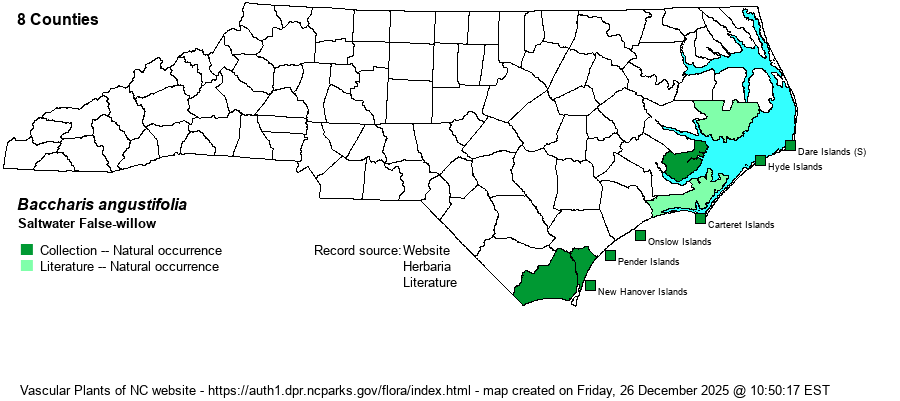| Author | Michaux | |
| Distribution | Strictly coastal, with records from Dare and all other coastal counties to the SC border. It is not yet recorded from VA, and not confirmed for Currituck County nor northern Dare. It does not occur away from tidal water in the state.
This is one of the few woody plants in the eastern states that is essentially limited to coastal areas. Its range is from northern NC, to southern FL, and then around the Gulf of Mexico to southern LA.
| |
| Abundance | Despite occurring in nearly all coastal counties, it is rare to extirpated in many of the northern counties. Generally uncommon in the southern counties, north to about Carteret County. It is a Watch List species in NC and is threatened perhaps by rising sea level and coastal storms. | |
| Habitat | This shrub is essentially limited to the margins of salt or brackish marshes, next to maritime forests and thickets. It may occur also in interdune swales, where the water is brackish. | |
| Phenology | Blooms from late September to October, and fruits quickly thereafter, in October. Thus, it is one of the latest blooming shrubs in the state (along with our other Baccharis species). | |
| Identification | Though this is an evergreen shrub, it has such narrow leaves that it can be easily overlooked when growing with other shrubs (such as Morella cerifera or B. halimifolia) along a brackish or salt marsh edge. It grows only to 3-6 feet tall and can have a fairly narrow and upright crown, also not easily catching attention. The leaves are very narrow, dark green and shiny, to about 1-1.5 inches long but barely 1/4-inch wide. What will catch attention is the abundance of white “fluffy flowers”, actually the fruit, seen on the shrubs in October. B. halimifolia has essentially identical fluffy white fruit, but that species has much wider, pale glaucous blue-green leaves and usually grows much wider and taller. And, for every B. angustifolia plant you see, you will likely see 25 to 100 individuals of B. halimifolia, one of our commonest coastal shrubs. | |
| Taxonomic Comments | None
| |
| Other Common Name(s) | False-willow. As much as it would be helpful to have all three of our Baccharis species to have the same group common name, references generally give each a completely idiosyncratic name that shows no relationships among them or even to other species. That is very sad! | |
| State Rank | S2 | |
| Global Rank | G4 | |
| State Status | W1 | |
| US Status | | |
| USACE-agcp | FACW link |
| USACE-emp | | |

